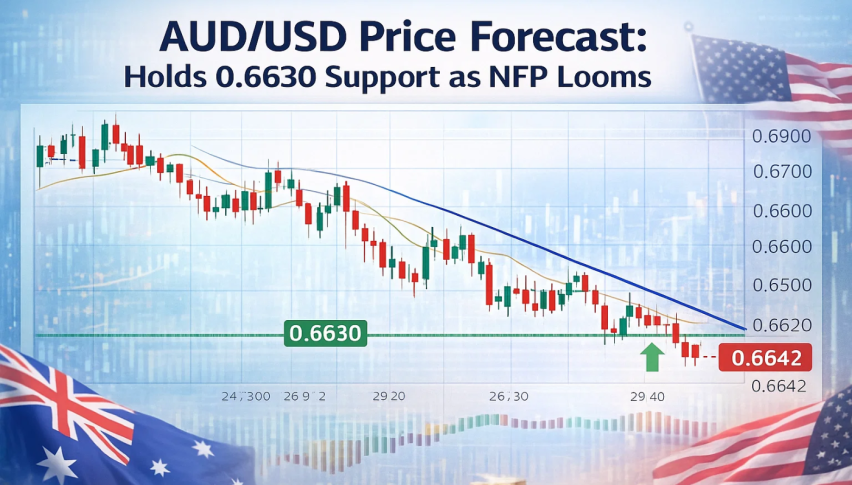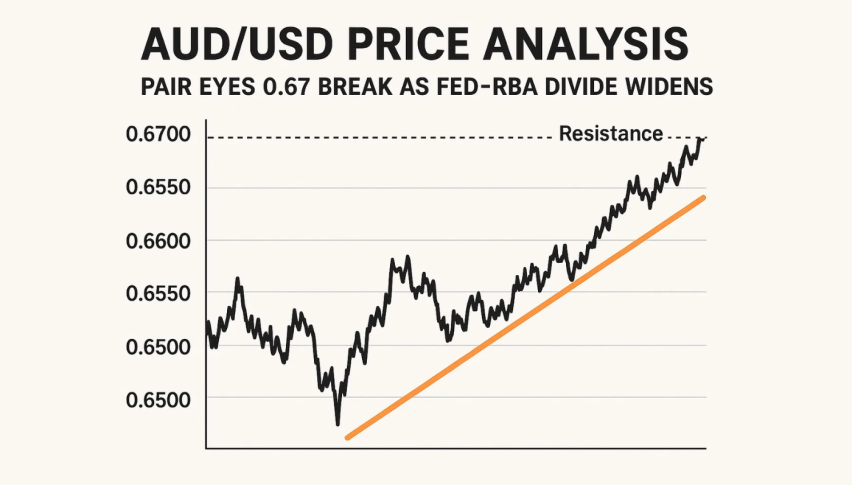Prices Forecast: Technical Analysis
The predicted daily closing price for AUD/USD is 0.6680, with a range of 0.6670 to 0.6690. For the weekly forecast, the expected closing price is 0.6700, with a range of 0.6680 to 0.6720. The technical indicators suggest a bullish sentiment, as the RSI is at 58.33, indicating upward momentum. The ATR of 0.0043 suggests moderate volatility, which could lead to price fluctuations within the predicted range. The price has been trading above the pivot point of 0.67, reinforcing the bullish outlook. The recent price action shows a series of higher lows, which supports the upward trend. Additionally, the ADX at 29.86 indicates a strengthening trend, further supporting the bullish forecast. Overall, the combination of these indicators suggests that AUD/USD may continue to rise, with potential resistance at 0.6720.
Fundamental Overview and Analysis
AUD/USD has shown a consistent upward trend recently, driven by positive economic data from Australia and a weaker US dollar. Factors such as rising commodity prices and strong employment figures have bolstered the Australian dollar’s value. Market sentiment remains optimistic, with investors viewing the AUD as a safe haven amid global uncertainties. However, challenges such as potential interest rate hikes by the Federal Reserve could impact the currency pair. The current valuation of AUD/USD appears fair, considering the economic indicators and market conditions. Investors are closely monitoring geopolitical developments that could influence the currency’s performance. Opportunities for growth exist, particularly if Australia continues to benefit from strong trade relationships and commodity exports. However, risks include market volatility and changes in global economic conditions.
Outlook for AUD/USD
The future outlook for AUD/USD remains positive, with expectations of continued upward movement in the short term. Current market trends indicate a bullish sentiment, supported by historical price movements and recent economic data. In the next 1 to 6 months, the price is expected to range between 0.6700 and 0.6800, driven by ongoing demand for Australian exports and a stable economic environment. Long-term forecasts suggest that AUD/USD could reach 0.7000 within the next 1 to 5 years, assuming continued economic growth in Australia and stable global markets. External factors such as geopolitical tensions or significant economic shifts could impact this outlook. Overall, the combination of strong fundamentals and positive market sentiment supports a bullish trajectory for AUD/USD.
Technical Analysis
Current Price Overview: The current price of AUD/USD is 0.6675, slightly lower than the previous close of 0.6680. Over the last 24 hours, the price has shown a slight downward movement, indicating some volatility but maintaining a generally bullish trend. Support and Resistance Levels: Key support levels are at 0.6670, 0.6660, and 0.6650, while resistance levels are at 0.6700, 0.6720, and 0.6740. The pivot point is at 0.67, and the asset is currently trading just below this level, suggesting potential upward movement. Technical Indicators Analysis: The RSI is at 58.33, indicating a bullish trend. The ATR of 0.0043 suggests moderate volatility, while the ADX at 29.86 indicates a strengthening trend. The 50-day SMA is at 0.6615, and the 200-day EMA is at 0.6575, showing a bullish crossover. Market Sentiment & Outlook: Sentiment is currently bullish, supported by price action above the pivot point, a rising RSI, and a strengthening ADX.
Forecasting Returns: $1,000 Across Market Conditions
The table below outlines potential investment scenarios for AUD/USD, providing insights into expected returns based on different market conditions.
| Scenario | Price Change | Value After 1 Month |
|---|---|---|
| Bullish Breakout | +5% to ~$1,050 | ~$1,050 |
| Sideways Range | 0% to ~$1,000 | ~$1,000 |
| Bearish Dip | -5% to ~$950 | ~$950 |
FAQs
What are the predicted price forecasts for the asset?
The predicted daily closing price for AUD/USD is 0.6680, with a weekly forecast of 0.6700. The price is expected to range between 0.6670 to 0.6690 daily and 0.6680 to 0.6720 weekly.
What are the key support and resistance levels for the asset?
Key support levels for AUD/USD are at 0.6670, 0.6660, and 0.6650. Resistance levels are at 0.6700, 0.6720, and 0.6740, with the pivot point at 0.67.
What are the main factors influencing the asset’s price?
Factors influencing AUD/USD include economic data from Australia, commodity prices, and the strength of the US dollar. Investor sentiment and geopolitical developments also play significant roles.
What is the outlook for the asset in the next 1 to 6 months?
The outlook for AUD/USD in the next 1 to 6 months is bullish, with expectations of price movement between 0.6700 and 0.6800. Continued demand for Australian exports and stable economic conditions are key drivers.
What are the risks and challenges facing the asset?
Risks for AUD/USD include market volatility, potential interest rate hikes by the Federal Reserve, and geopolitical tensions. These factors could impact the currency’s performance and investor sentiment.
Disclaimer
In conclusion, while the analysis provides a structured outlook on the asset’s potential price movements, it is essential to remember that financial markets are inherently unpredictable. Conducting thorough research and staying informed about market trends and economic indicators is crucial for making informed investment decisions.



